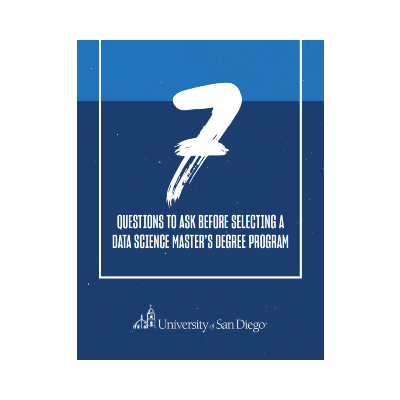If you’re exploring a career in data science, you’ve likely come across a number of programming tools. Python, in particular, is one of the most popular in the industry. It was first introduced in 1991 by Dutch programmer Guido van Rossum and is currently maintained by the Python Software Foundation.
The programming language software is free and widely used in the field of data science, and its popularity has dramatically increased within the last decade. In many cases, proficiency in Python is required for certain positions.
What Can Python Be Used For?
Common uses for Python include data analysis, machine learning, web development, automation or scripting, software testing and prototyping. Additional applications include use in the gaming industry to create prototypes, financial quantitative and qualitative analysis, search engine optimization and natural language processing. Many well-known companies use Python, including Google, Instagram, Intel, IBM, Netflix, Facebook and Spotify.
Is Python Necessary in Data Science?
In a word — yes. You’d be hard-pressed to find a data science position that doesn’t require at least some basic knowledge of Python.
As upGrad explains: “Python is the most widely used data science programming language in the world today … This general-purpose and dynamic language is inherently object-oriented. It also supports multiple paradigms, from functional to structured and procedural programming.”
How Is Python Different From Other Programming Languages?
Python is one of a handful of popular programming languages. Others include R, JavaScript, Java, Matlab, C, C++, Scala, SQL, CSS and others.
It’s intuitive, easy to learn and easy to use.
According to the Flatiron School, “Python provides all the necessary tools for the 4 steps of problem solving — data collection and cleaning, data exploration, data modeling and data visualization. Python also has a number of advanced deep learning libraries which makes it the default language for artificial intelligence. The versatility of Python makes it the key factor in it being the most popular language for data science.”
The following information was compiled from the Flatiron School and Simplilearn:
| Programming Language | Pros | Cons |
| Python | Popular among data scientists; a large amount of support and available resources; wide range of open source tools for visualization | Slow for computation compared to other languages |
| JavaScript | Best used for web development; excellent choice for creating visualizations | Does not contain the range of data science packages and built-in functionality |
| Java | Ability to build complicated applications from scratch; can deliver results faster than other programming languages | Not as flexible as some other languages |
| R | Easy to learn; powerful scripting language; can handle large and complicated sets of data; excellent choice for performing statistical operations | Lacks basic security; cannot be embedded into a web application |
| C/C++ | Ideal for projects with scalability and performance requirements; extremely fast; one of the earliest programming languages | On the more complicated side for beginners |
| SQL | A non-procedural language (does not require traditional programming logic); most widely used for regional databases | Difficult interface; some versions can be expensive |
| MATLAB | Used for teaching linear algebra and numerical analysis; important educational tool; large library of predefined functions | Slower execution than a compiled language; program can be costly |
| Scala | Excellent choice when working with high volume data sets; large number of libraries; easy language to understand | Limited community presence; may have a steeper learning curve; does not offer a lot in terms of backward compatibility |
| Julia | Ideal for numerical analysis and scientific computing; can be used as a low-level programming language; best used for data visualization; extremely fast; easy to learn | Not a large community, which can make it hard to find the answers you need |
| SAS | Used for analyzing statistical data; ideal for business intelligence | Must have a proper license to use all applications; lacks graphic representation |
7 Reasons to Learn Python
- One of the most versatile coding languages
In fact, some may argue that Python is the most universal coding language, especially within the last 5–10 years. As Coursera explains, “Python is a general-purpose language, meaning it can be used to create a variety of different programs and isn’t specialized for any specific problems. This versatility, along with its beginner-friendliness, has made it one of the most-used programming languages today.”
- Easy to learn and understand
It’s no secret that coding and programming languages can be quite complex, but one of the big draws to Python is its ease of use. Defined as “accessible” by UpGrad with a simplified syntax, “Python codes can be easily written and executed much faster than other programming languages.”
- Open source
Python was created under an Open Source Initiative (OSI) license, which means the programming language is free to use and distribute, even for commercial use. OSI is a nonprofit “with global scope formed to educate about and advocate for the benefits of open source and to build bridges among different constituencies in the open source community.”
- Improves your job prospects
Knowledge of and experience with Python is frequently required for many data science, artificial intelligence (AI) and machine learning (ML) positions. For example, jobs that use Python include data scientist, machine learning engineer, quality assurance engineer and backend developer, among others.
Even if Python isn’t required, learning this popular programming language widens your prospects and demonstrates your commitment to continuing education. Plus, it may set you apart from other candidates during the hiring process.
- Excellent standard libraries
In the programming world, a library is a collection of codes and modules that have already been assembled (a module is essentially several related codes saved in one file). Python has more than 137,000 libraries to choose from; some of the best include Requests, Pillow, Scrapy, Tkinter, Six and aiohttp.
- High demand for developers and related positions
A search for “Python developer” on LinkedIn revealed more than 60,000 results, with top companies like Google, Pandora, Yahoo, Deloitte and Comcast hiring for these positions. And as we mentioned earlier, Python is often required for data scientist, AL, ML and software engineering positions, of which there is a great need.
Data scientist jobs in particular are expected to grow by 36% between 2021 and 2031, which is extremely fast compared to the average growth rate of 5% for most other occupations. Bonus — Python has even created a job board that lists relevant positions around the world.
- A supportive, robust community
According to Coding Nomads, Python has been tagged in more than one million questions on the Q&A platform Stack Overflow. Python also features a separate Community hub on its website that includes forums, shared stories, a link to the Python Developers Community on LinkedIn, access to the Python Discord group and much more.
Where Can I Learn Python for Data Science?
Python itself offers a beginners guide for both programmers and non-programmers. You can also sign up for free or paid third-party online courses.
Other options include a data science bootcamp or a master’s degree program, both of which will typically include Python in the curriculum.
The University of San Diego’s Master of Science in Applied Data Science program teaches Python in relevant courses to train the data scientists and leaders of tomorrow. We believe that it is essential for our graduates to be prepared for the challenges of an ever-changing and quickly growing field.




